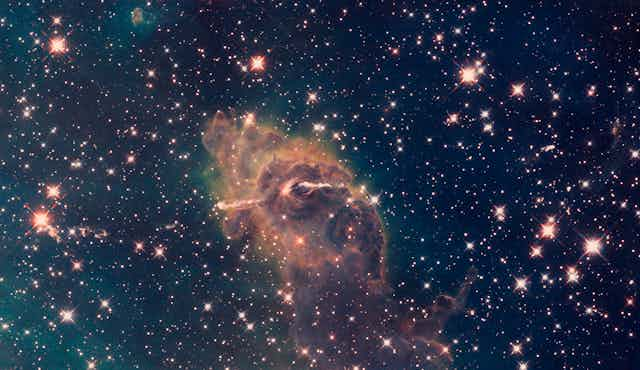In 1999, US space agency NASA launched the Stardust spaceship with what seemed then to be extraordinary aims. The first task of the mission was to take pictures of a comet, before diving into its tail to collect samples of comet dust. The second was to collect any other dust it could; perhaps some that had its origin outside the solar system.
Seven years later, Stardust passed by the Earth and dropped a capsule containing the dust it had captured. Analysis revealed that it had caught about a million particles, and since then astronomers have been working through the data to understand what story these particles tell us about our solar system, its origin and the universe beyond.
The list of particles has now been finally whittled down to seven particles that scientists are sure originated outside the solar system. In a paper published in Science, Andrew Westphal of the University of California at Berkeley and colleagues, revealed details about these particles. “We think that we have just taken the first baby step in understanding the complexity and diversity of interstellar dust,” he said. “At the highest level, this is about understanding our own origins.”
But what makes this finding even more exciting is that some of the particles were discovered by volunteer members of the public involved in Stardust@home, one of the first citizen-science projects to be set up.
Hunting stardust
The collection of this elusive interstellar dust was made possible by a special collector on-board the spacecraft, which was exposed for a total of 200 days during the spacecraft’s initial mission.
One of the problems with collecting space dust is the incredibly high speeds at which these particles travel – around 72,000kmph. This means that dust collection is accompanied by a strong impact to the craft’s sample collector and precautions had to be taken to ensure that the particles were not damaged or vapourised.
Westphal said this was achieved by slowing the craft down to a minimum speed. “The exposure periods were chosen to minimise the impact speed of interstellar dust on the collector.”
Another measure taken to ensure smooth sample collection was the use of a special material for the sample collector. Aerogel, a material NASA claims is 1,000 times less dense than glass, is arranged in tiles to cover the majority of the sample collector.

From far, far away
Why is this dust so important? Interstellar dust formed our solar system – the sun, the planets and us – and is still forming new solar systems right now. For many years there have been ongoing studies into “pre-solar” grains. These are ancient dust particles that predate the formation of our sun and whose origins lie in stars that survived during the creation of other solar systems.
All we know about interstellar medium so far comes from telescopic observations, or from on-board dust analysers on some of the previous space probes. Being able to hold such particles on Earth and look at them with the most powerful instruments would reveal a lot more.
It took many years to narrow down particles from a million to seven because most particles were so small. Nearly all of them were a few millionths of a metre (a micrometre) long or smaller. Scientists hadn’t nailed down all the methods to distinguish interstellar dust particles, which added to delays.
This was one reason why NASA launched the volunteer programme, Stardust@home, in August 2006. It enabled selected members of the public – those who passed a preliminary test – to scour microscope images of the aerogel and aluminium foils, hunting for telling signs of dust impact. This revealed that five of the seven particles were discovered. As an incentive, those who were the first to find a particle were offered the chance to name it and also appear as a co-author on the scientific papers that detailed their findings.
The interstellar dust particles are different from other errant dust because of their chemical composition. The seven particles have completely different chemical compositions, compared to those on Earth and even from each other. Some of them have unusual crystal structures, which may be the result of physical treatment in a nebula, which is what stars and solar systems are made from.
“Each of the particles tell us a story of its history through its structure and elemental composition,” Michael Rowan-Robinson, of Imperial College London, said.
The other way to distinguish these particles from solar system dust is the speed of the impact with the collector. Interstellar dust was predicted to be travelling at high speeds. And because the cleverly designed aerogel is transparent, it helped in identifying the impact tracks.
The claim that these particles are definitely from outside the solar system will need to be double-checked, but Rowan-Robinson is encouraged by the developments in this area. “I expect that there will now be proposals for further missions of this type,” he said.


